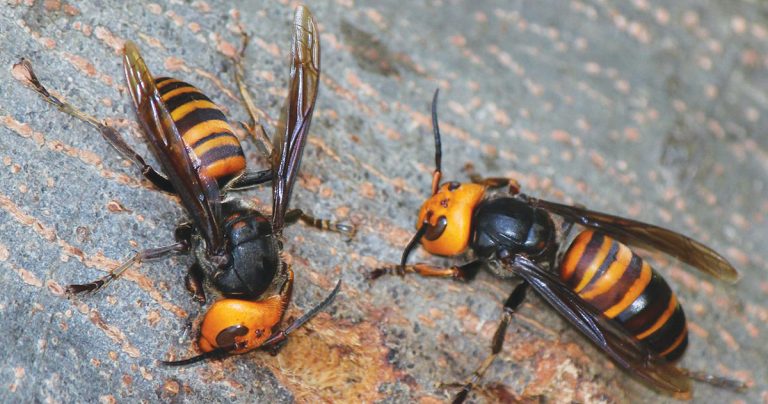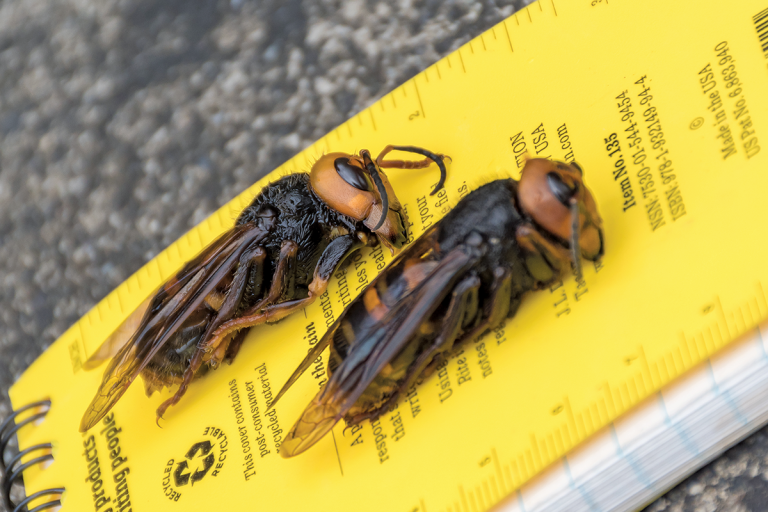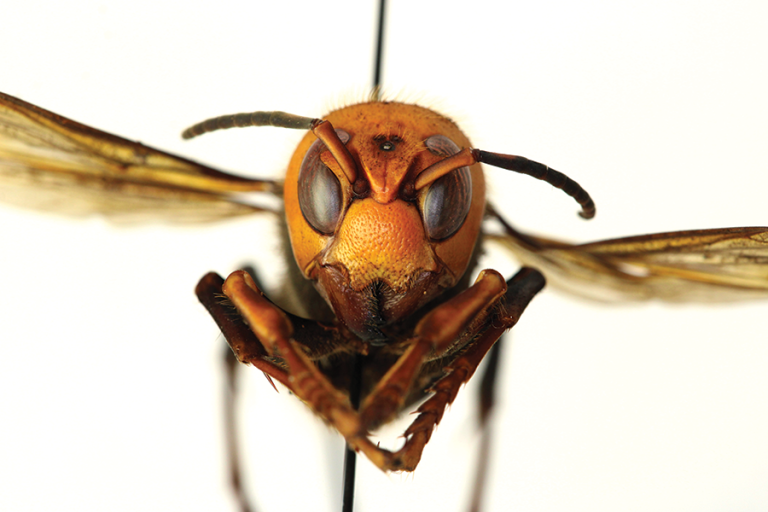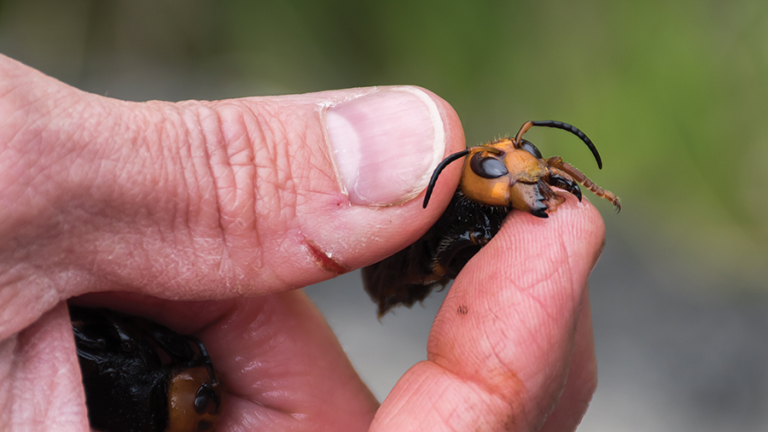Free printed copies of pest alerts are available.
Vespa mandarinia
The northern giant hornet (Vespa mandarinia) is native to temperate and tropical eastern Asia and is widely distributed throughout northern India, Myanmar, Laos, Korea, China, Taiwan, Japan, and parts of Russia. The northern giant hornet is very large, and measures about one and a half to two inches in length and may weigh more than an ounce. Colonies of these hornets begin in the spring when a single queen forms a nest underground in rotten tree roots or abandoned burrows. Above-ground nests are extremely rare but may occur in tree hollows, though still close to the ground. Nests in human structures are even more rare—Matsuura and Koike (2002) reported only three nests in human buildings out of 1,756 total nests observed. The queen lays up to five eggs per day and workers begin to emerge about 30 to 40 days (depending upon temperature) after colony establishment. Colony activity can continue for about six months and ends with the death of the queen in the fall. In the late summer and fall, reproductive males and new queens are produced, mate and disperse, and the new queens overwinter to start colonies in the spring of the following year. During the peak of colony activity there may be as many as 150 to 200 workers per colony (Archer 1995).

Detection in North America
The northern giant hornet was detected in North America in the fall of 2019 in British Columbia and Whatcom County, Washington, where it was probably introduced through international trade on cargo ships. It is unknown when the hornets may have been introduced. A nest in British Columbia was eradicated later that year (Garvey 2020), but the discoveries of queens in late May and June of 2020 in Washington State and British Columbia have renewed concern about the introduction. Modeling suggests that there is ample habitat suitable for northern giant hornet in the United States, including the Pacific Northwest, Midwest, and the Eastern seaboard. Most of the intermountain West, desert Southwest, and plains appear to be less suitable (Zhu et al. 2020). According to the Washington State Department of Agriculture (WSDA 2022a), the only confirmed sightings and nest eradications of this hornet have been in northwest Washington State and adjacent British Columbia. Four nests have been located and eradicated since the hornet was confirmed in 2019, and there have been no confirmed sightings in 2022. A map of sightings is available(WDSA 2022b). In the past, many confirmed sightings have come from members of the public, demonstrating that citizen science is a useful tool for tracking this species. Suspect hornet sightings can be reported on the WSDA website or on the EDDMapS website.

Are Northern Giant Hornets a Threat?
Northern giant hornets probably do not pose a serious human health risk. They will vigorously protect their nests if disturbed, inflicting a painful sting. While their venom actually has a lower acute toxicity than that of honey bees, each sting can administer large doses of venom due to the size of the wasp. The potent venom causes pain and swelling (Main 2020). Despite the toxicity and volume of a northern giant hornet sting, human deaths caused by this species seldom exceed a dozen each year in countries where it is native.
All Vespa species are predators of numerous insects. Northern giant hornets prey on many species, including caterpillars, chafer beetles, praying mantises, honey bees and other social Hymenoptera. During late summer and autumn, northern giant hornets begin to prey on honey bee hives, including cooperative attacks that can destroy a hive’s defenses in under two hours. The northern giant hornet is a natural enemy of Asian honey bee (Apis cerana), which has developed numerous defensive behaviors during their coevolu-tionary history. European honey bees (Apis mellifera) lack effective defensive behaviors for northern giant hornets, and the hornets may be a major source of colony loss. The potential impact on commercial honey bee production is among the primary reasons the appearance of northern giant hornet in North America has caused such concern.
Lookalike Wasp Species
Several wasp species that occur in the United States may be mistaken for the northern giant hornet. These lookalikes include the western and eastern cicada killers (Sphecius grandis and S. speciousus) and others. Comparisons between the northern giant hornet and these lookalikes can be found on the North Carolina State Extension website. To date, the only verified finds of the northern giant hornet have been in British Columbia and Washington State (see map) and it is unlikely that you will find this invasive hornet in other states in the United States. Therefore, citizens should refrain from killing large wasps because they believe them to be northern giant hornets, and instead call your local university Extension office or local agricultural commissioner’s office to report a suspected find. Take a picture to help with the identification.
Despite its painful sting and pestiferous attacks on honey bees, northern giant hornets have characteristics that are distinctly useful to people. Northern giant hornets probably play an impor-tant role in the ecology of regions where they are endemic and are even considered a conservation priority species in Korea where deforestation has caused habitat loss. Northern giant hornet larvae and prepupae are considered a delicacy by people that coexist with the hornet within its natural range. And the northern giant hornet is a source of Vespa amino acid mixture (VAAM); a mixture that may enhance athletic performance (Sasai et al. 2011, Tsuchita et al. 1997, Abe et al. 1995).


For additional information please take a look at the following resources:
Washington State University Extension fact sheet.
Washington State Department of Agriculture fact sheets.
New Pest Response Guidelines—Vespa mandarinia, Asian giant hornet. 2020. USDA APHIS PPQ.
Washington State Department of Agriculture. 2022a. The Northern giant hornet story map.
Washington State Department of Agriculture. 2022b. Reported Northern Giant Hornet Sightings.
Zhu, G., J.G. Illan, C. Looney, and D.W. Crowder. 2020. Assessing the ecological niche and invasion potential of the Asian giant hornet. Proceedings of the National Academy of Sciences, 117(40):24646-24648. doi.org/10.1073/pnas.2011441117.
National Geographic articles on Northern giant hornet arrival in the U.S. available at www.nationalgeographic.com
Credits
Authors
Chris Looney (Washington State Department of Agriculture), Timothy Lawrence (Washington State University Extension Service), Matt Baur (Western IPM Center), Steve Elliott (Western IPM Center).
Cited Literature
Abe T, Takiguchi Y, Tamura M, Shimura J, Yamazaki K. 1995. Effects of Vespa amino acid mixture (VAAM) isolated from hornet larval saliva and modified VAAM nutrients on endurance exercise in swimming mice-improvement in performance and changes of blood lactate and glucose.
Japanese Journal of Physical Fitness and Sports Medicine, 44:225–238. doi:10.7600/jspfsm1949.44.225
Archer M. 1995. Taxonomy, distribution and nesting biology of the Vespa mandarinia group (Hym: Vespinae). Entomologists Monthly Magazine 131: 47-53.
Garvey, K. 2020. About Those Asian Giant Hornets… May 4, 2020.
Main, D. 2020. Why are ‘murder hornet’ stings so intense? National Geo-graphic Magazine. Published May 14, 2020.
Matsuura, M. 1988. Ecological study of Vespine wasps (Hymenoptera, Vespinae) attacking honeybee colonies. 1. Seasonal-changes in the frequency of visits to apiearies by vespine wasps and damage inflicted, especially in the absence of artificial protection. Applied Entomology and Zoology, 23: 428-440
Matsuura, M., Koike, K. 2002. Studies on the ecology of social wasps and bees in urban environments 1. Records on aerial nests of the giant hornet, Vespa mandarinia japonica (Hymenoptera : Vespidae) within human buildings, Medical Entomology and Zoology, 53(3): Pages 183-186
Sasai H, Matsuo T, Fujita M, Saito M, Tanaka K. 2011. Effects of regular exercise combined with ingestion of vespa amino acid mixture on aerobic fitness and cardiovascular disease risk factors in sedentary older women: a preliminary study. Geriatrics and Gerontology International, 11:24–31.
Tsuchita H, Shirai-Morishita Y, Shimizu T, Abe T. 1997. Effects of a Vespa amino acid mixture identical to hornet larval saliva on the blood bio-chemical indices of running rats. Nutrition Research, 17: 999-1012. doi.org/10.1016/S0271-5317(97)00064-X
This work is supported by the Crop Protection and Pest Management Program (2022-70006-38001) from the USDA National Institute of Food and Agriculture.
For information about the Pest Alert program, please contact the North Central IPM Center at northcentral@ncipmc.org.
December 2022

